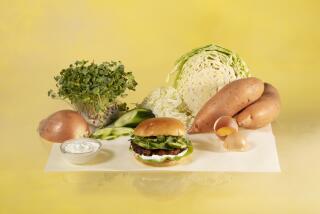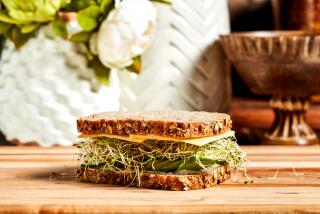The Seedy Side : The crisp veggies contain a variety of nutrients and offer a multitude of tastes.
- Share via
No longer regarded as mere “rabbit food” or the 1960s flower children’s vegetable of choice, bean and vegetable sprouts have gained popularity. They are now considered a wholesome addition to a healthy diet.
Sprouts are raised year-round in greenhouses with compost as the growing base. Or they can be grown hydroponically. This method of growing entails the use of liquids only--no soil.
A fresh supply of sprouts is only a jaunt away at your local grocer or farmers market.
Tova Malmstedt raises her sprouts hydroponically. Malmstedt, located in Ojai, sells a variety of sprouts wholesale to local health food establishments.
“I was a waitress before I bought the business nine years ago from a couple of hippies,” she said recently.
An acquaintance of hers, a real estate agent, approached her with the proposition. “He knew me to be one who ate health foods,” Malmstedt said. “I paid way too much for it, but I’ve turned it around into a pretty solid business.”
Her interest in “health foods” was more than just a preference for wholesome foods. It was an alternative to the medicines that Malmstedt had taken after undergoing colon cancer surgery years ago.
Now in her mid-40s, Malmstedt is a firm believer in the advantages of eating sprouts and other vegetables.
“My doctor swears by them,” she said. “He eats 3 1/2 pounds a week. Every morning for breakfast he eats plain yogurt with sprouts. Yuck!”
Malmstedt may not particularly like her doctor’s breakfast preference, but you won’t find her knocking somebody for enjoying the sprouting goodness of sweet peas, mung beans, daikon radish, sunflower, red lentils and alfalfa. All of which and more are offered through Tova’s Living Foods.
Before there are sprouts, there are seeds. Malmstedt employs a “Rototech 1000” to coax the seeds to sprout. This large wheel-like contraption slowly revolves four transparent compartments, called quadrants, which are laden with seeds.
As the quadrants revolve continuously, a timer “waters each one for 15 seconds, every five minutes,” Malmstedt said. “The seeds have little mouths that intake oxygen and the churning of the wheel aerates the sprouts so they don’t become waterlogged.”
Depending on the variety, the sprouts are left to grow in the quadrants for up to four days. Some varieties, such as the sweet pea, can take up to two weeks to grow.
“Then they are washed to remove the hulls,” Malmstedt said, and dried in a centrifuge-like spinning device. The sprouts are then packaged and sent on their way.
Most varieties only spend two days in the revolving quadrants. “After the seeds have just sprouted, we transfer them to cartons and flats where they finish growing in a greenhouse,” Malmstedt said. There, the sprouts continue to grow--usually for another three to four days. “We then go in and cut them down,” she said.
If you frequent Ventura County farmers markets, you may be familiar with the offerings of Christine White and Dexter Scott.
Their 20 or so varieties of “Jazzy Sprouts” have been sold at Ventura’s farmers markets on Wednesdays and Saturdays for over a year. And they are selling sprouts at the recently opened Thousand Oaks and Oxnard farmers markets (both held on Thursday).
With Christine on percussion and Dexter on saxophone, the Army Reserve musicians hammer out tunes while customers decide which sprouts to take home.
“Much of the time we spend educating the shoppers,” White said. “We tell them the various ways to use sprouts and what’s healthy about them.” White said the benefit of ingesting sprouts has been common knowledge for centuries.
“The Vikings sprouted seeds in blankets while at sea,” she said. “They ate them while at sea to help ward off scurvy and as an alternative to meat.”
Just how healthy are sprouts?
We asked Camarillo Health Care District registered dietitian Susan Speer. She said they certainly are healthy for you, but are no substitute for a well-balanced diet.
“What they have most of is Vitamin A,” she said. Given their compactness, sprouts are often used in greater quantity, therefore adding all the more vitamins. “You can eat a cup of sprouts on a sandwich,” she said, “whereas you might use one or two pieces of lettuce.”
Other vitamins and nutrients prevalent in various sprouts include, B, C, iron and protein.
Sprouts also offer a variety of flavors as well. Radish sprouts taste unmistakably like radishes, and sunflower greens have a nutty flavor, White said. She also grows a leek onion sprout “that tastes just like chives.
“And for a refreshing, sweet flavored drink, try wheat grass,” she said. Clipped straight from its growing flat, simply put it in a juicer to extract the juice.
White’s Jazzy Sprouts are priced at five ounces for $1, 10 ounces for $2 or 1 pound for $3.
“And don’t just use them for salads and sandwiches,” White said. “They’re great in tacos, burritos, soups, stuffed bell peppers--the list goes on and on.”
SERVING SUGGESTION BURGERS
This week’s serving suggestion was offered by Ojai sprouts grower Tova Malmstedt. Her Tova’s Living Foods line includes the colorful concoction known as Rainbow Mix. Five different sprout varieties make up this blend, including mung beans, lentils, red lentils, peas and the dark red azuki.
Rainbow Sesame Burgers
1 pound Rainbow Mix sprouts
1/2 cup sesame seeds
2 tablespoons soy sauce
1 teaspoon fresh crushed garlic
1/2 teaspoon of salt, basil and cumin
1/4 teaspoon of oregano, black pepper, ginger and curry powder
1 egg (optional)
In a blender or food processor, blend Rainbow Mix on a low speed for just a moment. Add rest of ingredients and mix again quickly. Mold into four large patties or 12 small patties for pita sandwiches. Fry quickly in hot vegetable oil until golden brown on each side. Serves four.
More to Read
Eat your way across L.A.
Get our weekly Tasting Notes newsletter for reviews, news and more.
You may occasionally receive promotional content from the Los Angeles Times.










